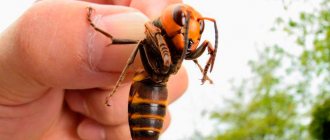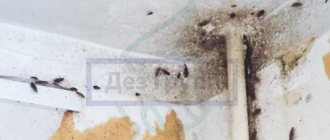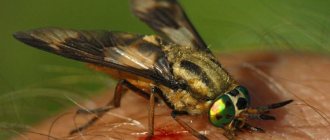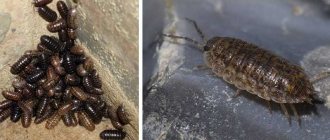The onset of the warm season is characterized not only by the hot sun and bright green grass. An integral element of this period is the abundance of flying and crawling insects.
Some of them live in a specific area without appearing in residential areas. Others, on the contrary, cause inconvenience to a person right in his home.
An unpleasant incident during the designated period is the penetration of midges into the ear canal. Often the situation occurs during outdoor recreation. Of course, this is a random event, because a fly is unlikely to plan an attack on a person.
Despite the discomfort that has arisen, you should not worry about your safety : the eardrum acts as a kind of partition that will not allow the midge to fly too deep.
What to do
Since the skin in the ear canal renews itself as quickly as nails, it is likely that the invading insect will be removed naturally. However, if there is discomfort and unpleasant sensations, you should take care to remove the parasite from the ear canal.
If a midge has flown into your ear, it is still not recommended to do something on your own. The best option is to contact a specialist who will not only remove the insect, but also treat the ear cavity to avoid the development of infections.
If this is not possible, it is worth providing the victim with qualified first aid.
The main measure of this is killing the insect. Please note: you should not carry out this procedure yourself.
Since the midge moves and buzzes, its presence in the ear causes significant discomfort:
- dizziness.
- Swelling of the affected area.
- Soreness.
- Nausea, vomiting.
- Short-term noticeable hearing loss.
- Headache.
To calm the uninvited guest, it is recommended to drop a few drops of alcohol tincture, mineral or any vegetable oil into the ear canal.
The insect will drown in the liquid, and the unpleasant symptoms will gradually disappear. In addition, the use of alcohol will provide additional disinfection.
Preparing to remove an insect
If a fly has flown into the ear, but has only climbed to a shallow depth, it is able to get out of the ear canal on its own.
Some measures will help speed up this process:
- bright light, such as from a table lamp, aimed directly at the affected area. It is believed that it will attract a fly and it will get out.
- No external influence on the ear canal. Do not put fingers or foreign objects into your ear.
- The sun's rays, since some types of insects love heat very much.
Sometimes, to get rid of it, it is enough to shake your head, as if water gets into your ears, and the affected ear should be directed downward. If the indicated manipulations do not bring results, the insect will have to be removed mechanically.
Insect removal
Since it is necessary to remove the parasite from the ear cavity as soon as possible, the simplest and most conservative method is to move the earlobe, tilting it towards the floor. If the midge has not managed to get deep enough, it will fall out of the ear canal under the influence of gravity.
The essence of the process of removing the uninvited guest is to wash the ear canal. All manipulations should be carried out slowly and calmly, without making sudden movements. It is better to take a sitting or lying position with free access to the source of the problem.
At home, the following preparations are most effective for rinsing::
- Camphor oil.
The most popular way to get rid of midges that have flown inside the ear. The main ingredient should first be heated a little, then dropped into the affected ear (4-5 drops).
Wait a little for the oil to bring the desired result, and then let the product flow out, turning your head in the right direction. Usually this method is enough to get rid of midges, which simply flow out along with the oil.
- Hydrogen peroxide.
The effectiveness of this product is explained by the formation of a large amount of foam. It will not only push the flying living creatures out, but will cleanse the ear canal of excess wax.
If these drugs do not bring the desired result, you should use plain water.:
- The pure liquid is heated to a warm state.
- The auricle is pulled back, thereby aligning the ear canal.
- Drop liquid into the affected ear using a pipette, a syringe without a needle, or a small syringe.
The principle of operation is similar to the method with oil.
A mandatory element of any of the above methods is a subsequent contact with a medical professional. If it was not possible to remove the insect from the ear on your own and with improvised means, the doctor will perform this procedure with a special device.
First aid
As first aid to a victim who finds himself in this awkward situation, it is recommended to drop a few drops of an alcohol solution or any alcoholic drink with a high alcohol content into the ear canal. This will disinfect the inner surface of the auditory organ to avoid possible infection from an insect. The alcohol vapor will stupefy the fly and either force it to crawl out, or calm it down and immobilize it. This will give the victim a break and sleep.
Methods for removing flies from the ear
Any vegetable oil will help you get a fly out of your ear at home. You need to drop a little of it into the ear canal and lie down so that it flows as deep as possible. It will prevent the insect from breathing and force it to crawl out. If this does not happen, then the pest, at least temporarily, will not be able to move freely.
If a fly is stuck in the ear and it was not possible to remove it on your own, the victim should contact a medical professional as soon as possible. At your doctor's appointment, explain in detail how the fly got into your ear and what measures were taken to remove it. With the help of special equipment, the doctor will be able to remove the fly from the ear without causing injury to the victim.
After the fly has been removed, the ear canal will be treated with an antibacterial agent. There should be no consequences after this incident. To prevent the fly from flying in again in the future, it is recommended to avoid close contact with the midges, which often hover near damp places or trash cans. When relaxing in nature, you need to wear hats or tie a scarf on your head.
Recovery after removing an insect from the ear
The restoration process is no less important than the immediate removal of flying animals from the ear cavity.
After visiting a doctor, you need to follow some recommendations:
- inspect the insect for damage. It is possible that the fly left some particles in the ear that will cause infection.
- Avoid heavy physical labor for a day after all manipulations. In order for your health to return to normal faster, you do not need to get up immediately after the procedure of suctioning out the infested parasite.
- Listen to your well-being. If an infection has formed inside the affected ear, it will make itself felt by an increase in body temperature, pain, swelling and dizziness. It is possible that there will be a short-term deterioration in hearing, which will go away on its own after proper treatment.
If you suspect possible complications, you should visit an otolaryngologist.
About the consequences of penetration
Tourists relaxing in the lap of nature especially often encounter similar situations. Such a case should not be ignored, since the consequences of the presence of a living creature in the ear can have very negative consequences.
- If a fly gets into the ear, it will try in every possible way to free itself from captivity, creating noise with its movement and irritating the walls of the ear canal. Such actions cause dizziness and pain in the head.
- Severe itching may also occur. Scratching the itchy area can damage the insect, resulting in deeper penetration of fragments of its body into the ear canal, which can cause serious illness. Therefore, you should never scratch an ear canal that has a fly, beetle, or other living creature inside it.
- Due to the fact that many flies feed on rotting organic waste and carrion, an insect caught in the ear opening can become a carrier of serious diseases.
What not to do
Independent attempts to remove an insect that has crawled into the auricle can result in deterioration or complete loss of hearing.
It is highly recommended not to pick at the outer ear with a cotton swab or toothpick, as this can lead to a number of unpleasant consequences.:
- injury to the skin with subsequent bleeding.
- Damage to the ear septum between the outer and middle ear (tympanic membrane).
- Partial extraction of living creatures. After some time, the remains of the insect’s body will decompose, which will cause infection of the ear canal.
- Pushing the midges even further, deeper into the ear canal.
An important nuance is to make sure that it is an insect and not some inanimate object that is in the ear cavity. Otherwise, water or other liquid will cause it to increase in size and it will be extremely difficult to remove it.
Please note: if there is a history of previous mechanical damage to the eardrum, rinsing the ear with water is prohibited, since fluid may enter the middle ear. Then the extraction of living creatures must be entrusted to a competent specialist.
Seeing a doctor
If the insect is close to the exit, then the methods described above will definitely help you, but if the midge has reached the eardrum, you should immediately contact an otolaryngologist rather than try to pull it out yourself.
The doctor will determine how to remove the insect from the ear during the initial examination. The method depends on the size and distance of the midge. Usually, the ear canal is washed with water or a furatsilin solution; in some cases, the midge can be removed with tweezers.
Preventing mosquito bites
To avoid the need for treatment, it is better to follow the rules of prevention in a timely manner:
- Use modern means of protection against mosquito bites. For example, DEET mosquito repellent spray. The aerosol form makes it easy to apply the product to skin or clothing. Thanks to the water-based formulation, it does not dry out the skin and does not contain alcohol.
- Try not to travel outside the city during periods of mosquito activity.
- Do not use perfumed products or wear bright clothes.
- Do not be near bushes and trees, as well as bodies of water.
Why does a mosquito fly into your ear?
A blood-sucking parasite can enter the hearing organ for two reasons:
- Accident. Most often this happens on the street, when a person walks during the day in a wooded area, near water bodies. Disturbed mosquitoes fly up from their shelters and move chaotically, finding temporary refuge in the ear, since the inside of it is dark, warm and humid.
- Intentional hit. After the ectoparasite has drunk a sufficient amount of blood from a person, it looks for a place to rest and digest food. In some cases, the insect does not fly far, but hides in close proximity to the victim, including choosing the ear as a refuge.
Preventive actions
Is it even possible to avoid insects getting into a child’s ear and nose? Can any preventive measures be used? In most cases, it is unrealistic to protect your baby from flying and crawling bugs and spiders, since in the summer they are almost everywhere. It is impossible to build a successful career without education; in fact, no employer will talk to a person without a degree. You can spend years gaining theoretical knowledge, but there is a real opportunity without the slightest risk











